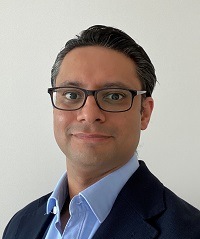This advertorial is sponsored by Perflow.

The Cascade Net (Perflow)—a non-occlusive remodelling net used in the treatment of cerebral aneurysms—is the first and only device capable of providing continuous blood flow during these repair procedures, and is designed to allow physicians to pack embolisation coils while also preventing risks of protrusion or entanglement into the mesh of the device. Paul Bhogal (Royal London Hospital, London, UK) discusses his experiences with this innovative technology, and how it compares to what was previously available in this space.
Bhogal, who has used the “classic” Cascade, the Cascade Agile, and to a lesser extent the Cascade17—which was launched in Europe earlier this year—considers these devices to be suitable for a wide range of aneurysm locations and complexities. These consist of those found in what he refers to as classic locations, including the internal carotid artery (ICA), as well as in middle cerebral artery (MCA) bifurcations and even more distal aneurysms, such as those in the anterior communicating artery (Acom), as the Cascade can safely handle tortuous anatomies. “For all of those locations, in the vast majority of cases, the use of the Cascade device is a good option,” he adds. “The classic situation where Cascade could be considered is wide-necked aneurysms—I have successfully used it for both ruptured and unruptured aneurysms, so in my experience it is suitable there as well.”
There is no shortage of benefits associated with the device from the physician’s perspective, according to Bhogal, with visual markers on the device making it very easy to see during procedures, and enabling it to be positioned correctly, with confidence, at the aneurysm neck. The Cascade’s handle—in addition to the two settings it offers, auto-lock mode and continuous mode—contributes to it being “very straightforward and intuitive to use”, in Bhogal’s view, while inflating and deflating the net is extremely simple as well. “The learning curve is relatively short, as it is not a complicated device to use,” he says. “The main thing is just learning where to position the device relative to the neck of the aneurysm—but that can be learned within one case, or even during training.” Bhogal adds that the option of partially resheathing the Cascade device while using it allows for focused deployment and controllable radial force, before noting that the interaction between the microcatheter and manipulation of the compliant net structure also supports its use in Y-bifurcations.
“I think there are a variety of ways in which the device could potentially mean that you see economic benefits in the long term—dense coil packing means recurrence is less likely, and therefore so is repeat treatment, for example,” Bhogal notes. “That is also nicer for the patient, as they do not have to come in and have the stress of dealing with a second or third operation.” Regarding characteristics that could be seen to benefit physicians and patients alike, Bhogal also touches on complications—or lack thereof—associated with the device. “Personally, I have not seen any complications when using the device, certainly no disastrous or major thromboembolic complications, or vessel ruptures. In fact, I think it would be extremely difficult to cause a vessel rupture because of the nature of the device. And, no complications—or, at least, a low rate of complications—means shorter hospital stays for elective cases, and improved outcomes for both elective and ruptured aneurysms overall.”
Best of both worlds

Regarding further patient-related benefits, Bhogal highlights the fact that the device’s mesh—which is based around Perflow’s proprietary CEREBRAL NET braiding technology—is tight, yet compliant and soft, making things “relatively atraumatic” for the patient undergoing a procedure with the Cascade. However, he believes an even more significant positive feature seen in the Cascade is the fact it is non-occlusive. One of the potential issues that is associated with remodelling balloons—a commonly used alternative approach to aneurysm repair—is the fact that they occlude the vessel they are deployed in, cutting off blood flow, and can therefore only be kept inflated for a limited period of time. “But, if you can create a device that will still allow blood flow through the blood vessels, and then also completely block the neck of the aneurysm so that you can just coil happily, then you have got the best of both worlds,” he says. That is where, Bhogal claims, the Cascade device comes in.
Problems relating to occluded blood vessels can be seen in a balloon-based procedure as short as five or ten minutes in duration—with Bhogal alluding to one case performed by a colleague of his that resulted in the patient having an anterior cerebral artery (ACA)- territory stroke despite the blood vessel only being occluded for a matter of minutes. As Bhogal notes, “something like the Cascade would have been much better” in this instance, before referencing a separate, anecdotal example from another colleague who had the Cascade net open for 45 minutes during a procedure and did not see any thromboembolic complications in the patient. “For me, this device represents something that is effectively as close to a balloon as possible, but is non-occlusive, meaning it has most of the advantages of a balloon without the major disadvantage,” he states, adding that the Cascade can therefore be seen as something akin to a “controllable and fully retrievable flow diverter”.
Freedom from complications
To assess whether there was any potential risk of coil loops intertwining with the Cascade device’s mesh mid-procedure, or protruding out of the target aneurysm and entering other blood vessels, Bhogal led a series of in vitro tests investigating how the device performed in silicone aneurysm models. A total of 480 attempted coilings were performed in these tests, and the results were published in the journal Interventional Neuroradiology (INR) last year. Bhogal and his colleagues concluded that no episodes of coil protrusion through the Cascade mesh were observed, and he further states that, due to the device’s mesh being so tightly woven, “the likelihood of coils interlooping with the device without you realising is almost zero”. In these tests, he and his colleagues also saw no coil protrusion into the parent vessel when the Cascade was deployed across the aneurysmal neck— concluding that the device therefore offers “robust protection” against coil herniation.
In addition to this evidence that the odds of any procedural complications occurring while using the Cascade are very low, Bhogal notes the other major finding from these tests—a flow-diverting effect, demonstrated by a flow-velocity reduction (FVR) of 23% and reduced intra-aneurysmal flow following inflation of the Cascade, compared to without the device in situ. “This means that, once the device is inflated, you are causing some stagnation in the aneurysm during the procedure while you are coiling,” he adds. “This also made me think that it is probably going to be safer in case of a ruptured aneurysm too, because you do at least have some flow diversion away from the aneurysm.” In summary, Bhogal states that—with the Cascade—the main innovation Perflow has brought to the market is “very good braiding technology”, before asserting that the company’s ability to create fairly small, controllable devices is “impressive”.
Paul Bhogal is a consultant interventional neuroradiologist at the Royal London Hospital—part of Barts Health NHS Trust—in London, UK, and the interventional neuroradiology research lead and co-founder of the Barts Research and Advanced Interventional Neuroradiology (BRAIN) conference. He has an interest in new devices and technologies, and has used the Cascade device in approximately 20 cases to date.

DISCLAIMER: The Cascade Net has received CE certification for use in Europe, but is currently not available for sale in the USA.









